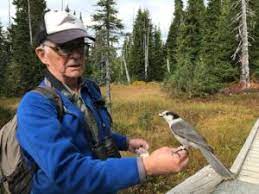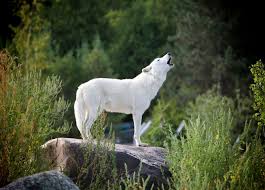STORES OF WOLVES and PEOPLE
THE BANCROFT TIMES (B.T.) – July 1904 – “At Portlock, Algoma district, wolves are causing great havoc among cattle and sheep. The farmers are much alarmed. Children are not allowed from their homes.”
February 1904 – Alex Morrisey of Turtle River, near Dauphin, had a thrilling experience with a pack of wolves while crossing Round Lake, an arm of Lake Manitoba. While a considerable distance from shore he was surrounded and attacked by twelve or fifteen ferocious animals. At the same time Morrisey had with him two hounds and an axe, and had it not been for these, he says, there is no doubt at all but that he would have been torn to pieces by the wolves. The hounds fought hard, and one of them was killed in the encounter. Morrisey claimed to have done great execution with his axe, and more than one wolf was killed, while others were badly wounded.” (B.T.)
Similar stories abound in small community papers such as The Times. Fact or fiction, real or perceived, the willing researcher can regularly read of wolves chasing lumbermen up trees, or doctors in their horse drawn carriages down darkened nighttime trails or of settlers huddling in fear within the safety of their log cabins at the Bruton Farm in Algonquin Park. But not all such wolf encounters were so dramatic.
In 1963 campers in Algonquin Provincial Park were enjoying a makeup game of baseball at the Lake of Two Rivers air field when suddenly a lone wolf materialized and stole second base. Literally. This bizarre behavior resumed when the wolf, presumeably the very same, returned to steal third. Nervous Ministry of Natural Resources staff tracked down the furry culprit and shot it, fearing that it might be rabid. Which didn’t prove to be after testing.
During the 1970s Rosy the wolf came upon the Algonquin scene, so named by park employees. She frequented the former park museum often to peer in through the windows. The following spring her pups became the source pack for Algonquin Park’s famed ‘wolf howls’ that by 2023 have attracted millions of park visitors. August is a great time ‘to howl’ for the pups are often quite happy to respond.
As an aside, it is not unusual to hear stories of campers howling from their campsites only to hear a wolf howl in response. Not unusually that response will be from campers at another campsite; not wolves.

It wasn’t unusual to see Rosy patrolling the campgrounds. The only action to her discredit was the eating of three park visitor’s dogs. She disappeared from the Algonquin scene after a couple of years just as mysteriously as she had first appeared.
In 1986 another curious wolf made its mark in the park. On a regular basis it was seen in the Pog Lake campground location. During the evening ‘wolf howls’ it would run up to campers, no doubt interactively inspiring their adrenalin flow. On one occasion it chewed on a car’s bumper. The wolf would touch people and walk by their campfires never exhibiting any signs of fear or aggression. As this wolf seemed fearless, people became fearless of it.
At 2:30 a.m., Sunday, August 9, 1987, a wolf was chased away from a campfire. Nearby, at her own campfire, sat a 16-year old girl. When the wolf approached she shone her flashlight in its eyes inspiring the wolf to grab her arm. She was wearing a thick woolen sweater and a sweatshirt. Communication & Biological Services Supervisor Dan Strickland said the girl received two scratches, each two inches in length in the shape of a “V”. “The wolf could have crushed her arm if it wanted.” He described the scratches as “tiny dots; incipient braking of the skin.” Strickland speculated that the damage was done when the girl jerked her arm in an attempt to free it. The wolf instantly released her arm, lingered for a while, scratched a nearby tent then sauntered off with a camper’s shoe.
At 10:00 a.m. the Ontario Provincial Police spotted the wolf near Pog Lake and after making a positive identification an MNR Conservation Officer dispatched it at 10:30 a.m. Subsequent tests proved that the wolf was not rabid.
George Kolenosky studied wolves in Algonquin Park during the 1960s. To him this was not an attack but “more in the nature of a disciplinary action; just as it might grab a subordinate pack member.”
With all of this publicity a camper came forward and claimed that he and his wife were sitting around their campfire when a lone wolf appeared, grabbed the man’s coat, and tugged. Then it put its jaws around the lady’s neck and then pulled on her pony tail. Did this really happen? Could it have been the same wolf?
On Wednesday, August 3, 1994, Ernie Martelle, Superintendent of Algonquin Provincial Park, confirmed that an Algonquin wolf had attacked 6 year-old Christopher Andrusek Jr., at his family campsite at approximately 7:30 p.m. Startled by the wolf the youngster ran, tripped and fell. The wolf pounced, the boy screamed, and the wolf let go. Attending physician Dr. Ian Parks, of nearby Barry’s Bay, discovered two wounds, one requiring stitches, the other broken skin. A search failed to find the wolf.
On Thursday, September 1, 1994, at a campsite on Hardy Bay, Lake Lavielle, an anonymous camper had turned to enter the tent when she was bit by a wolf in the back of her leg. The wolf had been standing nearby. Subsequently, on Friday, September 9 park rangers had to brake for a lone wolf that was standing on the roadway. Growling, it refused to yield. Believing that this was the wolf that they had been seeking the rangers dispatched it and sent it for testing.
Jack Borrowman, Area South Supervisor for Algonquin Park, wondered if perhaps this wasn’t the same wolf caught stealing donuts from a bear trap in the spring of ’94 near Radiant Lake. The trapper had taken a photo of the wolf and it appeared to be the same animal. In the meantime the MNR was looking for a camper in this area who had apparently video taped a wolf going through his packs two weeks prior to the latest incident. According to Borrowman, “it wasn’t interested in food.”
“I’m betting it was just a wacko wolf,” said Dan Strickland. “Wolves don’t attack people and this one just wanted to bite somebody. Its aberrant behavior. Fearless wolves such as this are a rare occurrence.”
Tests confirmed the wolf was not rabid.

Note: Dan Strickland is well-known for his Canada Jay studies and enthusiasm to name the Canada Jay as our national bird.
